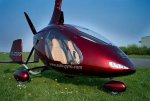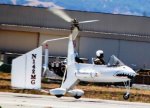This is reply to Fara’s post on the other thread with the accident to keep them separate.
I went from 2 seater gyro to single seat Sportcopter Vortex M912, and agree with Fara that more than 6 hours of training is needed. I also had a lot of off airport flying hours so that helped tremendously. The single seat gyro behaves much differently and is very nimble. I had two great gyro instructors, and one had experience flying the Sportcopter who was Chris Lord. We specifically trained for the transition and he described how the SC would behave differently as we trained together in the MTO he owned. Last flight I had with Chris he even got out of his MTO and told me to do 3 takeoff and landings solo so I can get familiar with how the SC would behave. That I believe was most important part of my training since it helped a lot for the first solo in the SC. Even with this training, I was still surprised at how responsive the M912 was on takeoff and how much I had to lower the noise on takeoff in comparison to the two seater. It is a very safe gyro to fly.
I have seen a student who soloed a trike for the second time actually cut power completely on takeoff in a panic, and fly right into the woods. Seen many 2 stroke engine outs too.
I have also seen several ultralight aircraft accidents with students Crow hopping, and highly do not recommend it. Better off getting away from the ground to get familiar with the aircraft handling rather than right on top of it. IMO. I even taxied a Phantom too fast down the runway which I never taxied or flew before, and it became airborne with a unexpected head wind and almost nose dove it into the ground trying to get it back on the runway. Decided full power to save the landing and flew around for 20 minutes to get use to how it handled then landed it without any issues. wont do that again... Luckily it flew just like a Cub which I had hundreds of hours in. Probably dumbest thing I have ever done. Glad I didn’t wreck it since the owner of the phantom was going to take my Cub as collateral...
New pilots for single seat gyros should try to find instructors with experience in flying the single seat gyro if possible to help in the transition...
I went from 2 seater gyro to single seat Sportcopter Vortex M912, and agree with Fara that more than 6 hours of training is needed. I also had a lot of off airport flying hours so that helped tremendously. The single seat gyro behaves much differently and is very nimble. I had two great gyro instructors, and one had experience flying the Sportcopter who was Chris Lord. We specifically trained for the transition and he described how the SC would behave differently as we trained together in the MTO he owned. Last flight I had with Chris he even got out of his MTO and told me to do 3 takeoff and landings solo so I can get familiar with how the SC would behave. That I believe was most important part of my training since it helped a lot for the first solo in the SC. Even with this training, I was still surprised at how responsive the M912 was on takeoff and how much I had to lower the noise on takeoff in comparison to the two seater. It is a very safe gyro to fly.
I have seen a student who soloed a trike for the second time actually cut power completely on takeoff in a panic, and fly right into the woods. Seen many 2 stroke engine outs too.
I have also seen several ultralight aircraft accidents with students Crow hopping, and highly do not recommend it. Better off getting away from the ground to get familiar with the aircraft handling rather than right on top of it. IMO. I even taxied a Phantom too fast down the runway which I never taxied or flew before, and it became airborne with a unexpected head wind and almost nose dove it into the ground trying to get it back on the runway. Decided full power to save the landing and flew around for 20 minutes to get use to how it handled then landed it without any issues. wont do that again... Luckily it flew just like a Cub which I had hundreds of hours in. Probably dumbest thing I have ever done. Glad I didn’t wreck it since the owner of the phantom was going to take my Cub as collateral...
New pilots for single seat gyros should try to find instructors with experience in flying the single seat gyro if possible to help in the transition...





